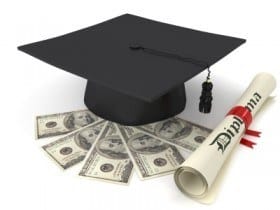Some Chapter 7 cases discharge student loans but the best solution is Chapter 13 for when an individual owes less than $360,000. Although a Chapter 7 or Chapter 13 bankruptcy student loan discharge is difficult, filing might make the debt noncollectable.
Bankruptcy Options for a Student Loan Discharge
Filing Chapter 13 normally makes a student loan affordable. I work with Chapter 13 cases where there is approval for payments as low as 100 per month. Additionally, it completely stops multiple garnishments. Technically, Chapter 13 payments could be a zero payment but something needs to be in the plan to pay the attorney.
Many Chapter 13 cases are filing to wait out the student loans for two major reasons and they are as follows:
1. Private student loans are not dischargeable but the statute of limitations and other defenses still apply to them. Only government student loans have no statute of limitations defense.
Today the U.S. Department of Education announced that the fiscal year 2016 national federal student loan cohort default rate (CDR) decreased from 10.8% for FY 2015 to 10.1% for FY 2016, a 6.5% decline from the FY 2015 rate. —September 25, 2019. Contact: Press Office, (202) 401-1576, press@ed.gov.
2. Student loan debt is now running well over a trillion in student loan debt. Incredibly, this is more than all the credit card or auto loan debt. So, at some point, the system will most likely change to allow a discharge. Interestingly, filing Chapter 13 often allows the person to convert later to take advantage of changes in the law.
The Income-Based Repayment Plan
There is the IBR (Income-Based Repayment plan). Most jurisdictions require you to the first file and attempt approval for the IBR before applying for a hardship discharge. However, there is no IBR for private student loan debts.
In some extreme cases, the judges will not require this extra step when the debtor shows and inability to repay even a small amount without hardship. If you are on a subsistence living there is no IBR that helps. IBR only consolidates the federally guaranteed student loans. Therefore, you have to start any student loan case by first determining if it is a private loan.
Discharges Over 10 Years if You Work for a Non-Profit | DOE Student Loans
Since 2007, working for a nonprofit corporation also discharges the DOE student loans over 10 years instead of 20 for income-based repayment plans. After 2012, almost all student loans at public schools were originated by DOE the department of education. But some private lending will probably always remain. Private loans have a much higher rate of default and problems.
The Student Loan Hardship Discharge
A Student Loan Hardship Discharge normally requires you first attempt an IBR or ICR Loan Repayment Plan. There is a requirement that you exhaust your administrative remedies before you ask for a hardship discharge of government loans. If your income is zero and the payment can be zero, there is probably no hardship. If a student loan discharge is an issue in your situation, please call and discuss it with meme. It may be worth a try because every year people do get them. The key is repayment must be a real hardship—not just hard.
Again, Chapter 7 or Chapter 13 bankruptcy student loan hardship discharge is very difficult to obtain. However, by waiting out the debt a person might get full disability and then discharge the debt. For debtors close to retirement this is a real benefit because of how easy it is to obtain the disability discharge for federal loans after age 65. Many clients file a Chapter 13 at age 55 and merely file two cases consecutively to wait out the student loan.
Resources for Student Loans
Other Related Information
Discharge Private Student Loans in Bankruptcy
Chapter 7 Student Loan Hardship Discharge
Do you need help managing your student loan? Contact my office right away to start the conversation. Nick C. Thompson, Attorney: 502-625-0905


